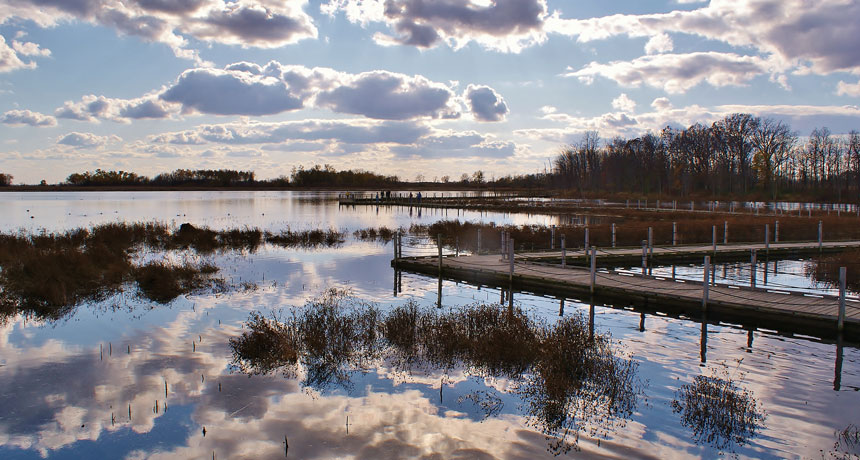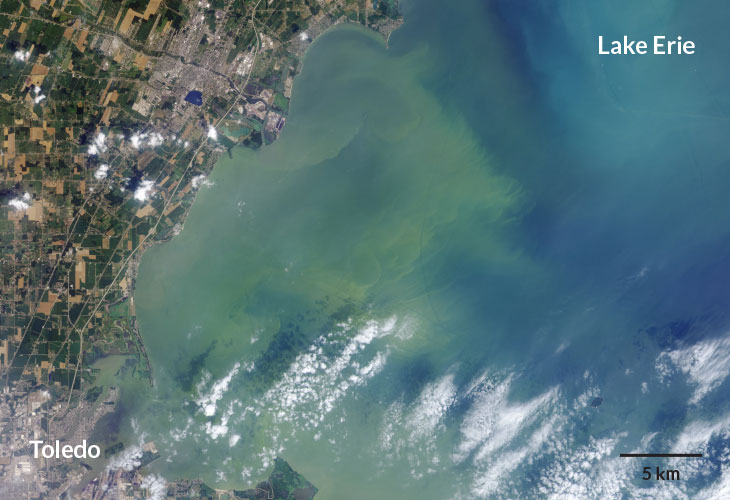We’re probably undervaluing healthy lakes and rivers
Economists often ignore the human health benefits of keeping water bodies clean

WAR ON WETLANDS Wetlands such as Wisconsin’s Horicon Marsh (shown) are natural water purifiers. A recent legal dispute has emerged over whether to count this environmental service as a benefit of protecting wetlands.
Chumlee10/Flickr (CC BY-SA 2.0)
- More than 2 years ago
For sale: Pristine lake. Price negotiable.
Most U.S. government attempts to quantify the costs and benefits of protecting the country’s bodies of water are likely undervaluing healthy lakes and rivers, researchers argue in a new study. That’s because some clean water benefits get left out of the analyses, sometimes because these benefits are difficult to pin numbers on. As a result, the apparent value of many environmental regulations is probably discounted.
The study, published online October 8 in the Proceedings of the National Academy of Sciences, surveyed 20 government reports analyzing the economic impacts of U.S. water pollution laws. Most of these laws have been enacted since 2000, when cost-benefit analyses became a requirement. Analysis of a measure for restricting river pollution, for example, might find that it increases costs for factories using that river for wastewater disposal, but boosts tourism revenues by drawing more kayakers and swimmers.
Only two studies out of 20 showed the economic benefits of these laws exceeding the costs. That’s uncommon among analyses of environmental regulations, says study coauthor David Keiser, an environmental economist at Iowa State University in Ames. Usually, the benefits exceed the costs.
So why does water pollution regulation seem, on paper at least, like such a losing proposition?
Keiser has an explanation: Summing up the monetary benefits of environmental policies is really hard. Many of these benefits are intangible and don’t have clear market values. So deciding which benefits to count, and how to count them, can make a big difference in the results.
Many analyses assume water will be filtered for drinking, Keiser says, so they don’t count the human health benefits of clean lakes and rivers (SN: 8/18/18, p. 14). That’s different from air pollution cost-benefit studies, which generally do include the health benefits of cleaner air by factoring in data tracking things like doctor’s visits or drug prescriptions. That could explain why Clean Air Act rules tend to get more favorable reviews, Keiser says — human health accounts for about 95 percent of the measured benefits of air quality regulations.
“You can avoid a lake with heavy, thick, toxic algal blooms,” Keiser says. “If you walk outside and have very polluted air, it’s harder to avoid.”
But even if people can avoid an algae-choked lake, they still pay a price for that pollution, says environmental scientist Thomas Bridgeman, director of the Lake Erie Center at the University of Toledo in Ohio.

Communities that pull drinking water from a lake filled with toxic blooms of algae or cyanobacteria spend more to make the water safe to drink. Bridgeman’s seen it firsthand: In 2014, Lake Erie’s cyanobacteria blooms from phosphorus runoff shut down Toledo’s water supply for two days and forced the city to spend $500 million on water treatment upgrades.
Most of the studies surveyed by Keiser and his team were missing other kinds of benefits, too. The reports usually left out the value of eliminating certain toxic and nonconventional pollutants — molecules such as bisphenol A, or BPA, and perfluorooctanoic acid, or PFOA (SN: 10/3/15, p. 12). In high quantities, these compounds, which are used to make some plastics and nonstick coatings, can cause harm to humans and wildlife. Many studies also didn’t include discussion of how the quality of surface waters can affect groundwater, which is a major source of drinking water for many people.
A lack of data on water quality may also limit studies, Keiser’s team suggests. While there’s a national database tracking daily local air pollution levels, the data from various water quality monitoring programs aren’t centralized. That makes gathering and evaluating trends in water quality harder.
Plus, there are the intangibles — the value of aquatic species that are essential to the food chain, for example.

“Some things are just inherently difficult to put a dollar [value] on,” says Robin Craig, an environmental law professor at the University of Utah in Salt Lake City. “What is it worth to have a healthy native ecosystem?… That’s where it can get very subjective very fast.”
That subjectivity can allow agencies to analyze policies in ways that suit their own political agendas, says Matthew Kotchen, an environmental economist at Yale University. An example: the wildly different assessments by the Obama and Trump administrations of the value gained from the 2015 Clean Water Rule, also known as the Waters of the United States rule.
The rule, passed under President Barack Obama, clarified the definition of waters protected under the 1972 Clean Water Act to include tributaries and wetlands connected to larger bodies of water. The Environmental Protection Agency estimated in 2015 that the rule would result in yearly economic benefits ranging from $300 million to $600 million, edging out the predicted annual costs of $200 million to $500 million. But in 2017, Trump’s EPA reanalyzed the rule and proposed rolling it back, saying that the agency had now calculated just $30 million to $70 million in annual benefits.
The difference in the conclusions came down to the consideration of wetlands: The 2015 analysis found that protecting wetlands, such as marshes and bogs that purify water, tallied up to $500 million in annual benefits. The Trump administration’s EPA, however, left wetlands out of the calculation entirely, says Kotchen, who analyzed the policy swing in Science in 2017.
Currently, the rule has gone into effect in 26 states, but is still tied up in legal challenges.
It’s an example of how methodology — and what counts as a benefit — can have a huge impact on the apparent value of environmental policies and laws.
The squishiness in analyzing environmental benefits underlies many of the Trump administration’s proposed rollbacks of Obama-era environmental legislation, not just ones about water pollution, Kotchen says. There are guidelines for how such cost-benefit analyses should be carried out, he says, but there’s still room for researchers or government agencies to choose what to include or exclude.
In June, the EPA, then under the leadership of Scott Pruitt, proposed revising the way the agency does cost-benefit analyses to no longer include so-called indirect benefits. For example, in evaluating policies to reduce carbon dioxide emissions, the agency would ignore the fact that those measures also reduce other harmful air pollutants. The move would, overall, make environmental policies look less beneficial.
These sharp contrasts in how presidential administrations approach environmental impact studies are not unprecedented, says Craig, the environmental law professor. “Pretty much every time we change presidents, the priorities for how to weigh those different elements change.”







